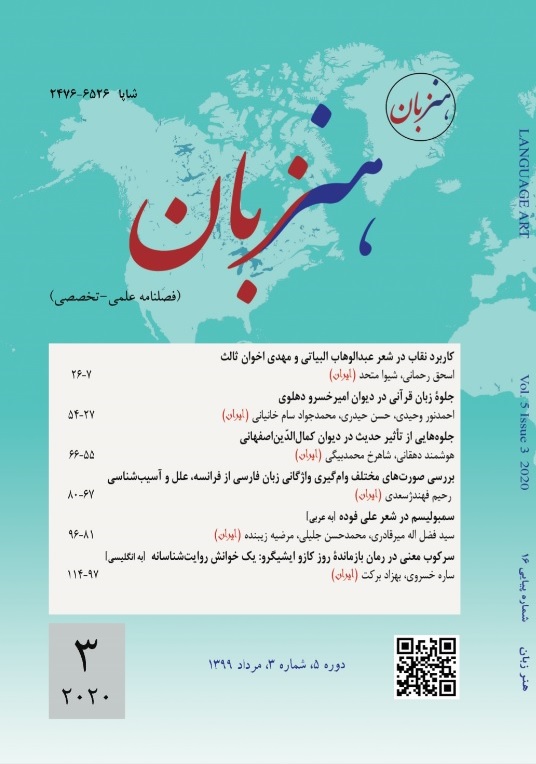سمبولیسم در شعر علی فوده
DOI::
https://doi.org/10.22046/LA.2020.17کلمات کلیدی:
الرمز، الصور الرمزية، علي فودة ، شعره .چکیده
نماد وسیلهای هنری برای بیان غیرمستقیم احساسات، نظرات، اشیا، عناصر، ایدهها، عواطف و فرهنگ است و استفاده از آن با اندیشه، شعور و گرایشهای روحی و ذهنی انسان ارتباط نزدیک دارد، زیرا ابزاری برای آشکار کردن جنبههای فعالیت فکری و فرهنگی انسان شدهاست. برای بیان زندگی و واقعیت به روشی غیرمستقیم هنری و آشکار ساختن حقیقت و واقعیت، و هنگامی که شاعر به دلیل فشار استعمار و اشغال نتوانست عقاید خود را بیان کند یا اعلام کند، با شعر یا نثر به نمادگرایی متوسل شد. بسیاری از شاعران فلسطینی این روش را برای بیان مسائل و نگرانیهای خود انتخاب کردند. و ایدههای خود را در مورد قهرمانی مردم فلسطین و رشادتهایشان در دفاع از سرزمین و میهن خود و مقاومت در برابر دشمن با قدرت، عزم راسخ و چالش در بازپسگیری حقوق خود و بازگشت مردم آواره فلسطین به سرزمین خود، به صورت نمادین بیان کردند. از جمله این شاعران میتوان به شاعر شهید فلسطینی علی فوده اشاره کرد که از نمادگرایی در سبکها و گونههای مختلف بهرهبردهاست. این پژوهش به بررسی نماد در شعر علی فوده شاعر فلسطینی از طریق روش توصیفی- تحلیلی میپردازد و روشن میسازد که شاعر در نمادهای خود از منابع مختلف از جمله: طبیعت، اسطوره، حیوانات، رنگ و برخی شخصیتهای مهم الهام گرفته است.مراجع
Al-Quran al-Karim
Abu Ali, Nabil (1999). al-fariq bayn al-usturat wa al-xarafat wa al-tārix , Journal of the Faculty of Arts, Helwan University, No. 5.
Abu, Farj (1982). elm anāser al-lawn, Italy, Milan, Dar Dakfan, Part 2.
Abushabab, Wasef (1988). al-qadim wa al-jadid fi al-ʃer al-arabi al-hadith, Beirut, Dar Al-Nahda Al-Arabiya
Adonis (n.d.) zeman al-ʃer, 6th Ed., Dar al-Saqi, da.m.
Al-Jundi, darvish (n.d.). al-ramziyat fi al'adab al-arabi, 1st Ed., Cairo, Nahdet Al-Misr for printing, publishing and distribution.
Al-khuri, lutfi (1990). Muja’m al-asātir, 1st Edition, House of General Cultural Affairs, Baghdad).
Al-qurean, Faiz Arif Sulayman (1984). Al-waʃm wa al-wasʃ fi al-ʃer al-jāheli, University Thesis, Yarmouk University.
Al-Samadi, Amtinan Uthman (2001). ʃer Sa’adi Yousef, 1st Edition, Beirut, Almasis is Arabic.
al-Tha’alibi, Abu Mansur (2001). fiqat al-lughat, Explained and presented to him by: Yassin Al-Youbi, 2nd Edition, Beirut: The Modern Library.
al-Tha’alibi, Abu Mansur abdulmalek Abu Muhamad (2001). fiqat al-lughat, Edited by Jamal Tolba, Beirut, Scientific Books House.
Al-umri, Zeynab Abdulaziz (1989). Al-lawan fi al-ʃer al-arabi al-qadim, Cairo, The Anglo-Egyptian Press.
Buqli, Ruzbehan (n.d.). ʃarh ʃathiyāt, edited by: Henri Cari: Tehran.
Fawda, Ali (2003) al-amāl al-ʃeriyat, Beirut: The Arab Foundation for Studies and Publishing.
Hamdan, Amiyat (1981). alramziat wa alrumantikiya fi al-ʃer al-lubnani, 1st Edition, Iraqi Republic, Dar Al-Rashid Publishing.
Hammam, Muhammad Yusuf (1930 AD): al-lwan, Cairo, Al-Etemad Press, 1st Edition.
Hawtash, Abdulrahman (1987). ʃer al-thurat fi al-adab al-arabi al-muāser, 1st Edition, Beirut, Knowledge Library.
Ibn Manzur, Jamal al-din Muhammad ibn Mukarram (1997). lisān al-arab, 5th Vol., Beirut: Dar Sader.
Ibrahim, Khalil & others (2005). marāyā al-tadhuq al-adabia dirāsāt wa al-ʃahādat, 1st Ed., Jordan: Amman, Darat al Funun, Khaled Shoman Foundation.
Jawad, Fatin Abduljabbar (2009). alwan lu’bat simiāiyat / bahath ejrāi fi taʃkil al-mani al-ʃeri, eamman , Amman, Majdalawi House for Publishing and Distribution.
Karam, Antoine Ghattas (1949). Al-ramziyat wa al-adab al-arabi al-hadith, Beirut, Dar Al-Scout.
Locher, Max (1992). rawānʃenāsi ranaghā, translated by: Leila Mehrdadpey Tehran: Hesam publishing.
Mukhtar, Ahmad (1997). al-dalālāt al-nafasiyat wa al-ejtemaeiat, 2nd Edition, Cairo, The World of Books.
Shahab, Usameh yousef (2000). Al-harkat al-ʃeriat al-nasawiat fi Palestine wa Jordan, 1st Edition, The Hashemite Kingdom of Jordan, Ministry of Culture.
Umar, Ahmad Mukhtar (1997). Al-lughat wa al-lawn, Cairo, Book Mark, Edition 2.
Zaher, Fars Metri (1979). Al-daw' wa al-lawn, Beirut, Dar Al-Qalam, 1st Edition.
Zaki, Ahmad Kamal (1981). al-tafsir al-usturi lil-ʃer al-hadith, Fusul Magazine, Volume 1, No. 4.
##submission.downloads##
چاپ شده
ارجاع به مقاله
شماره
نوع مقاله
مجوز
حق نشر 2022 Seyyed Fazlollah Mirghaderi, Mohammad Hassan Jalili, Marziye Zibande

این پروژه تحت مجوز بین المللی Creative Commons Attribution 4.0 می باشد.
فصلنامه هنر زبان یک مجله دسترسی آزاد است و مقالات پس از پذیرش در دسترس عموم قرار می گیرند و استفاده از آن با ذکر منبع آزاد است
